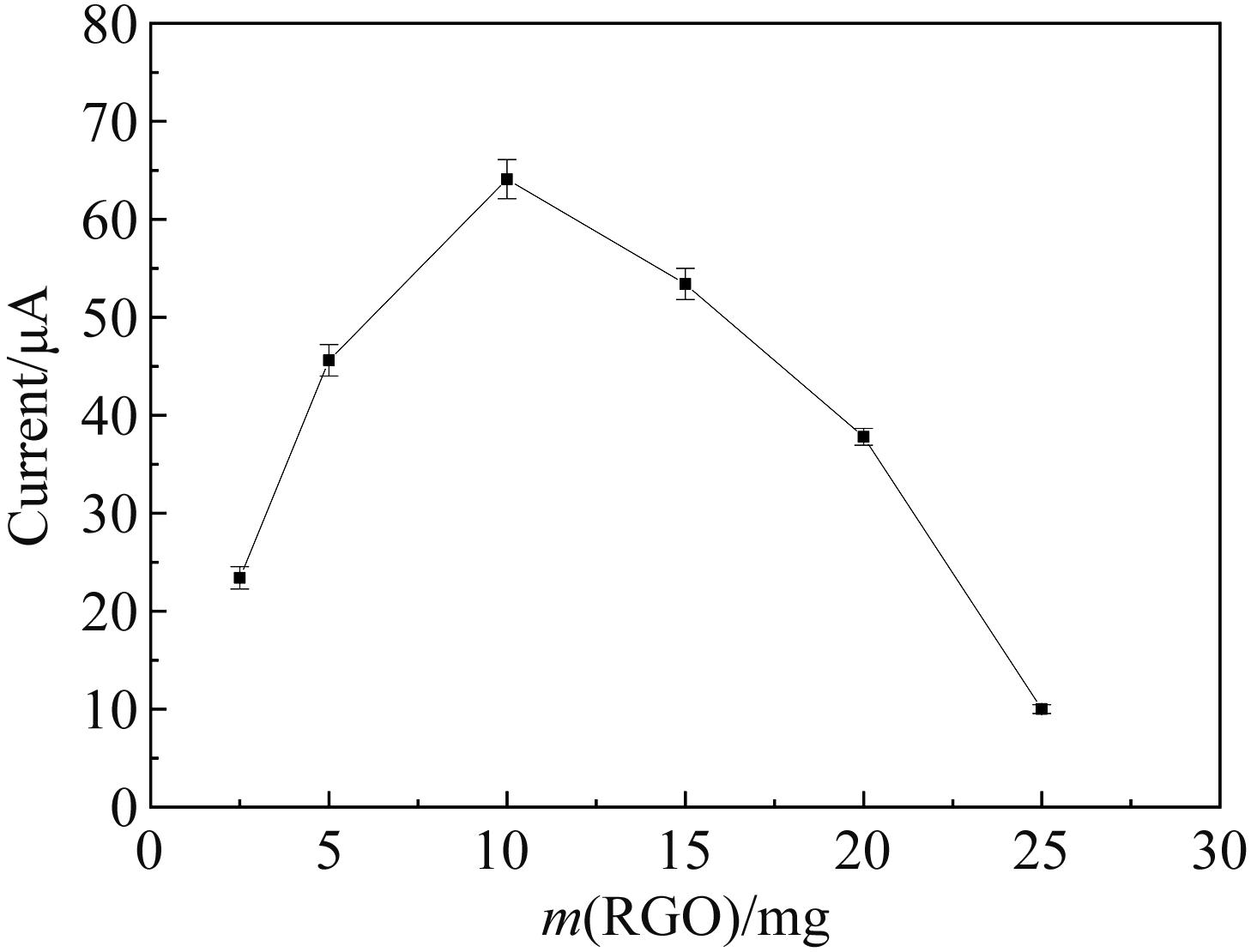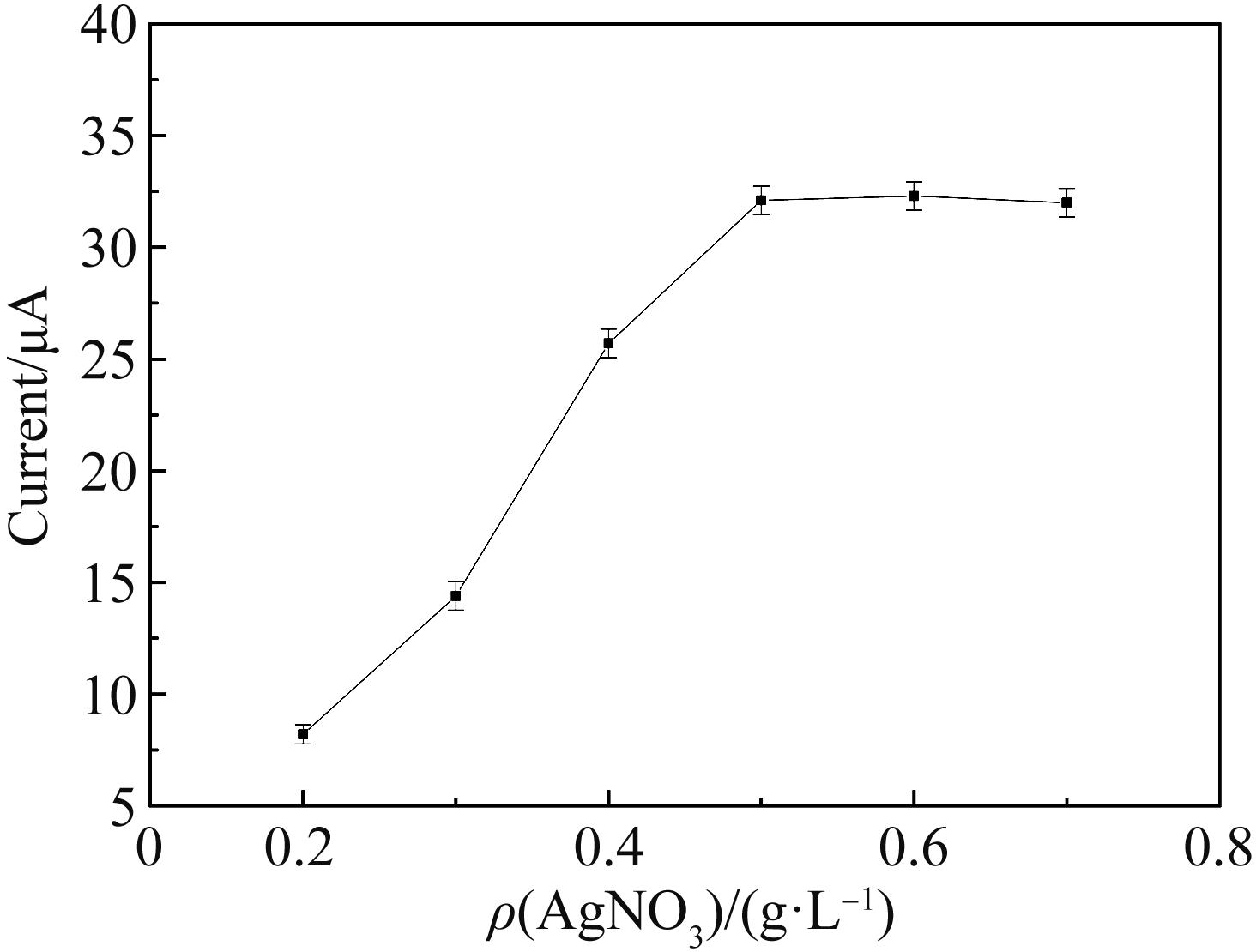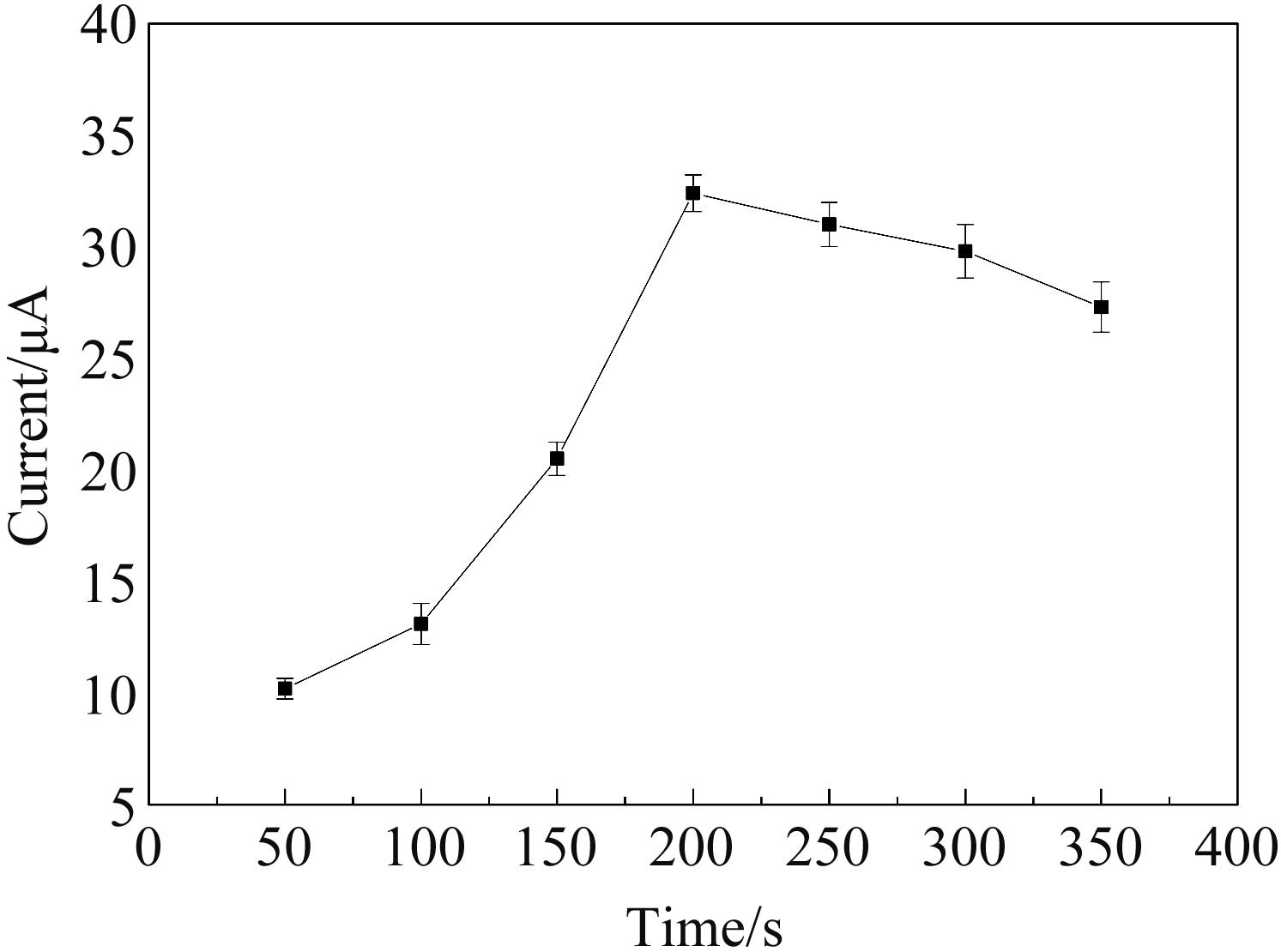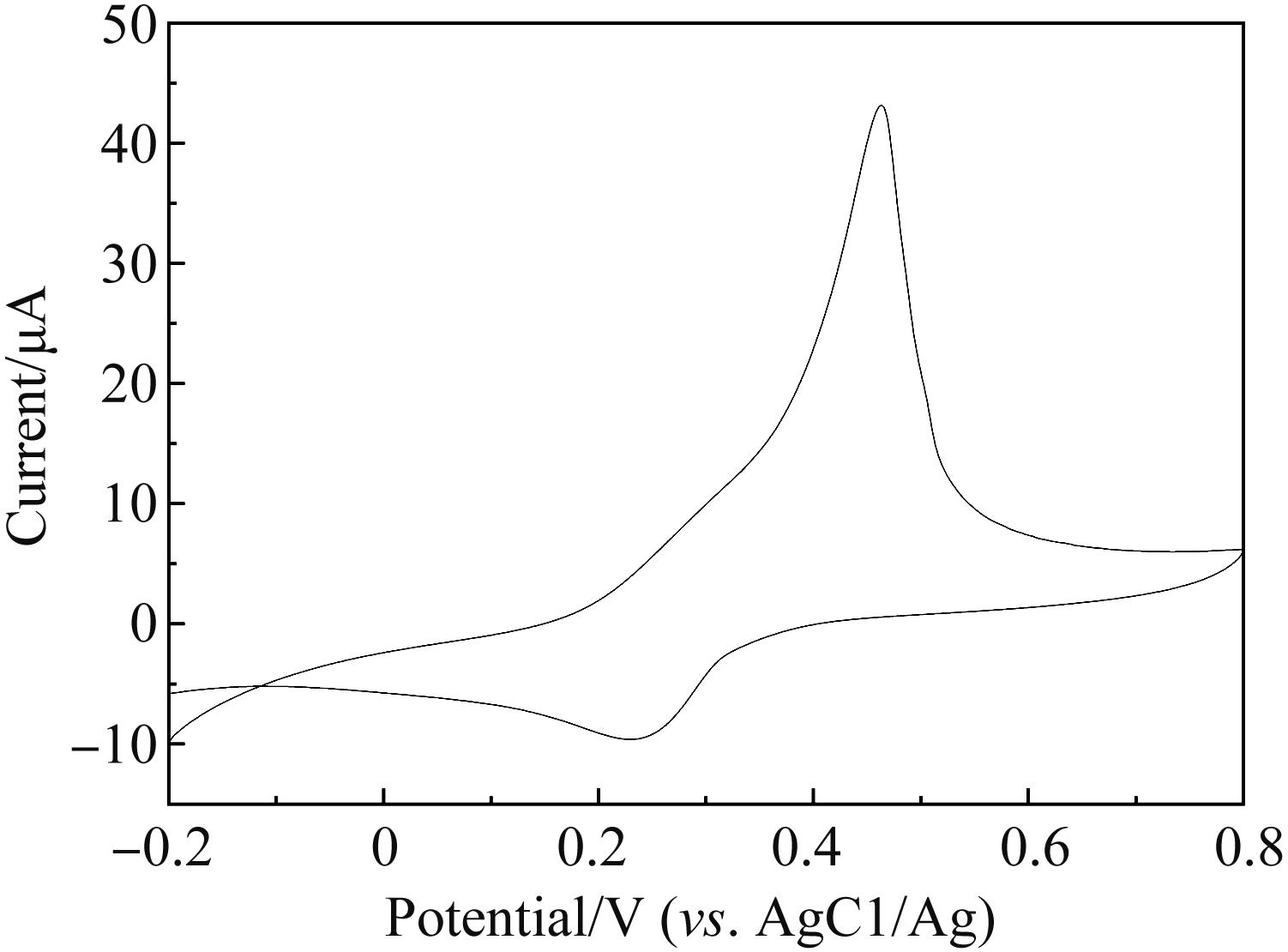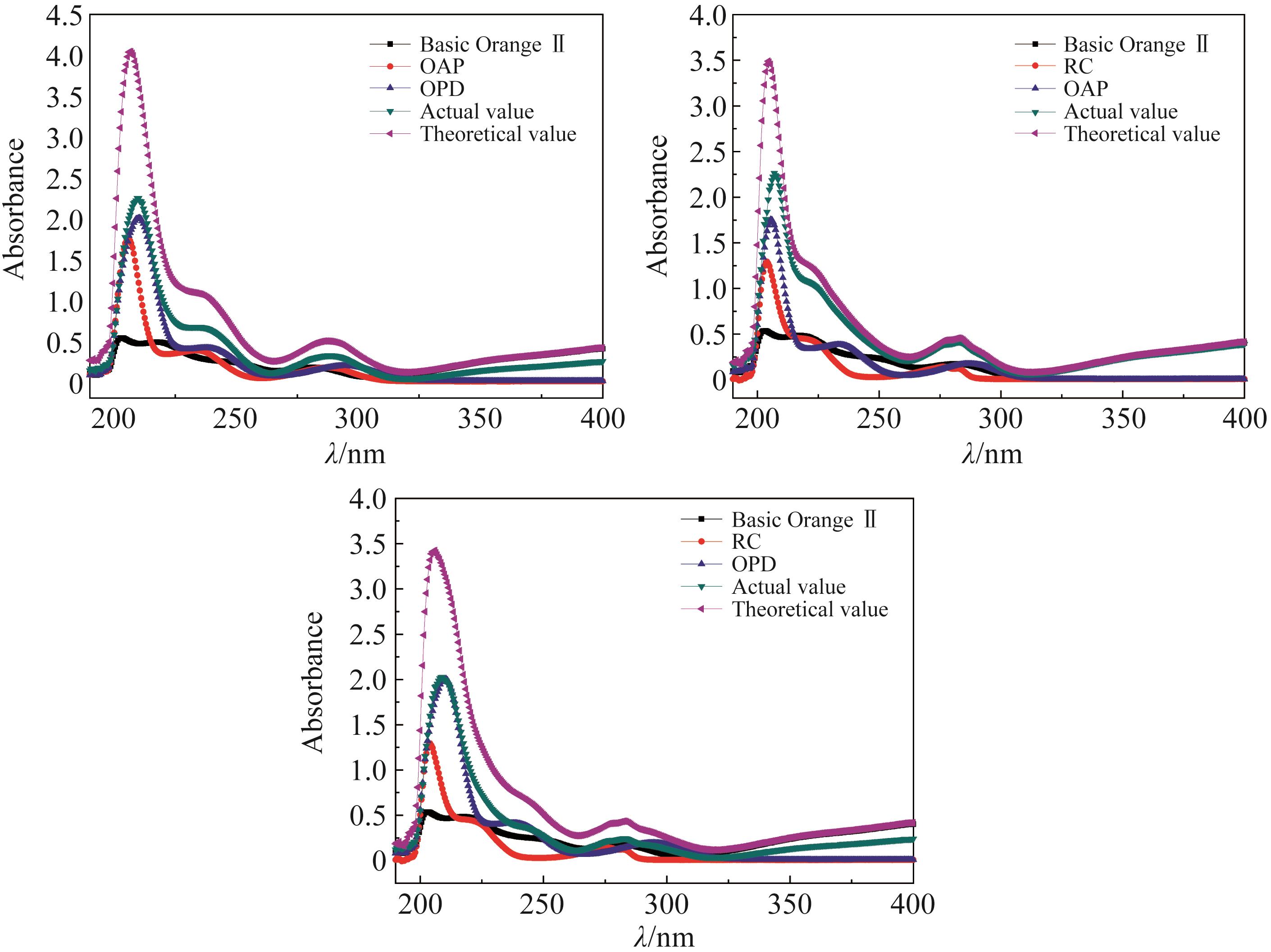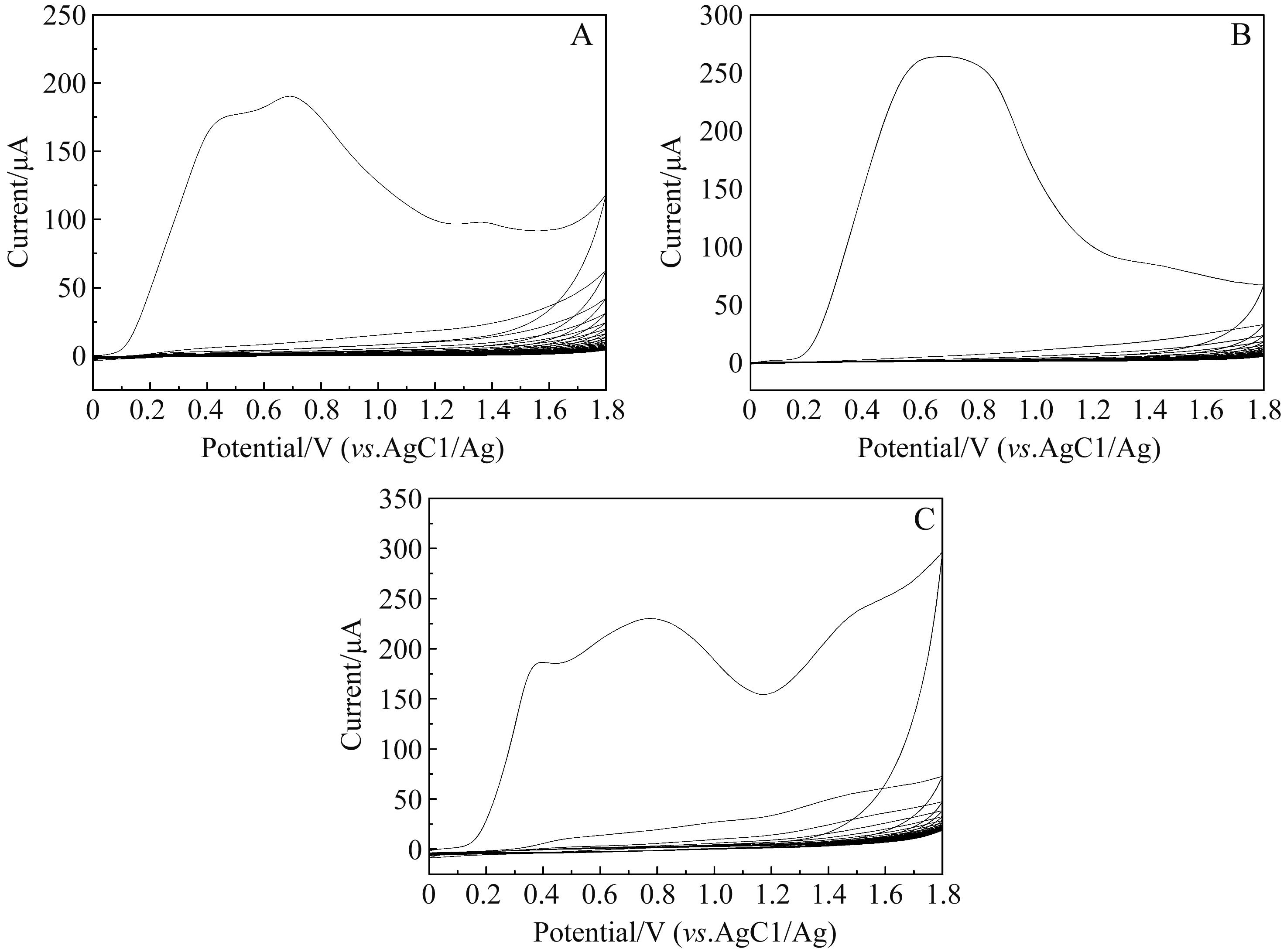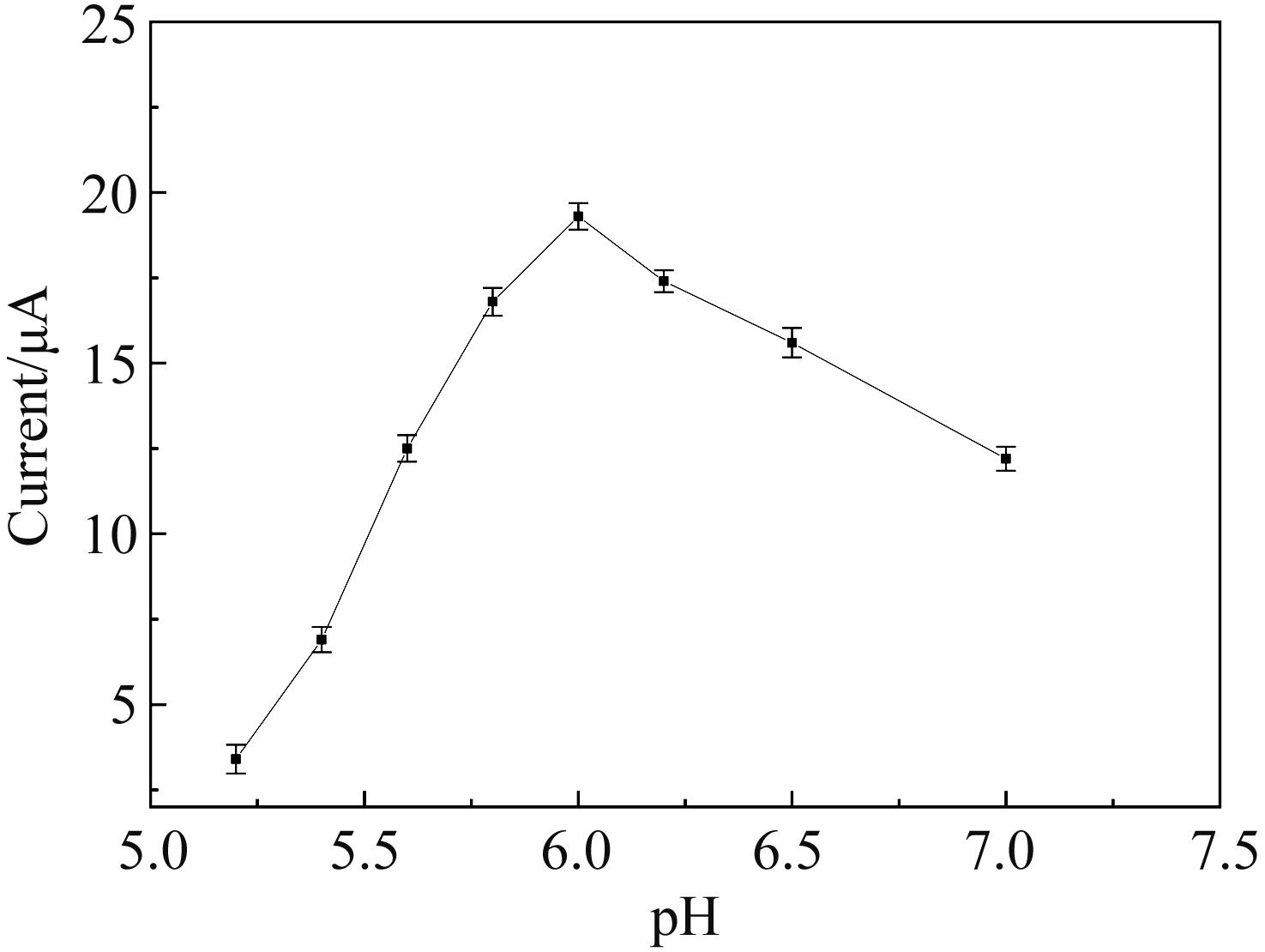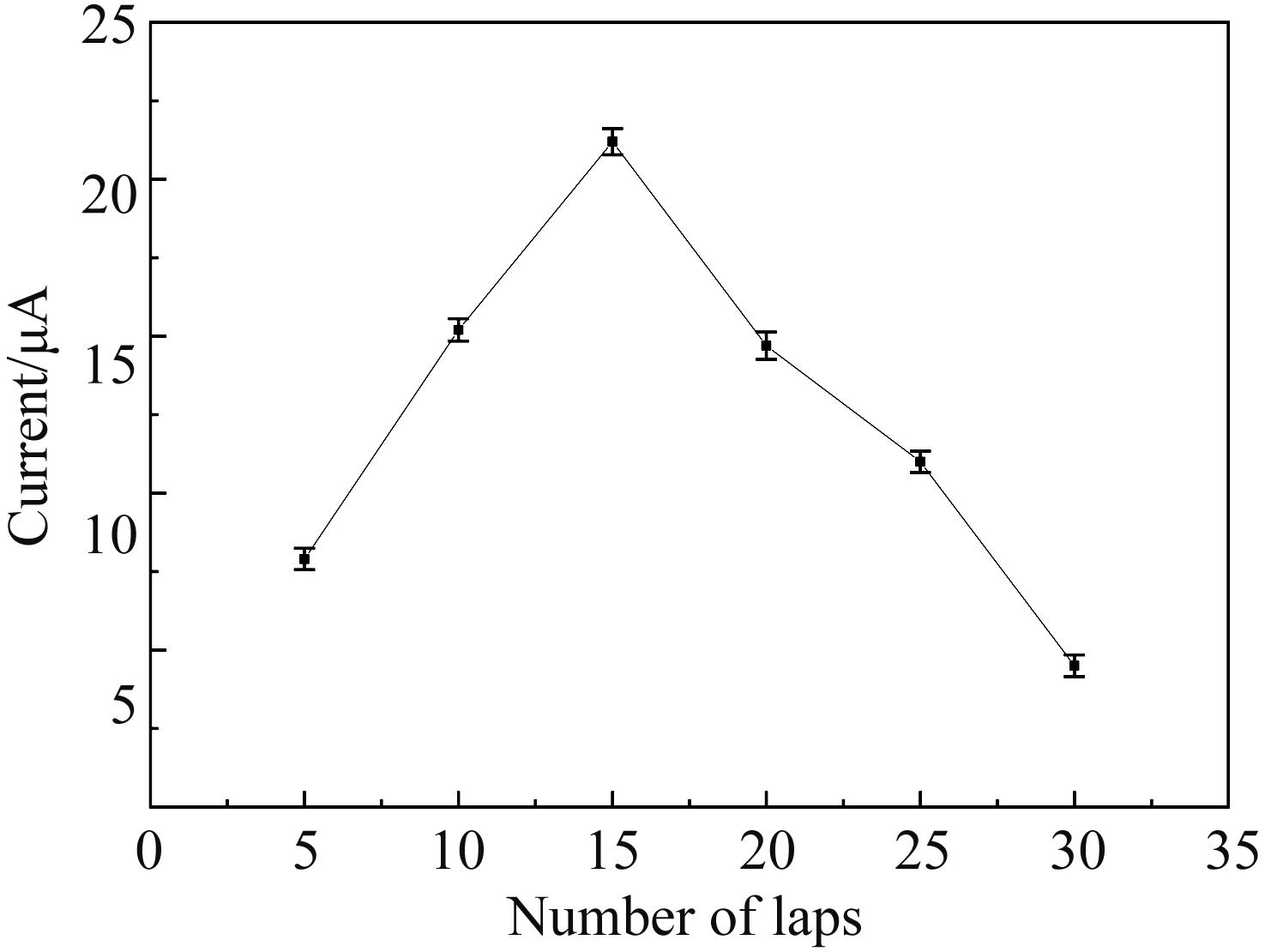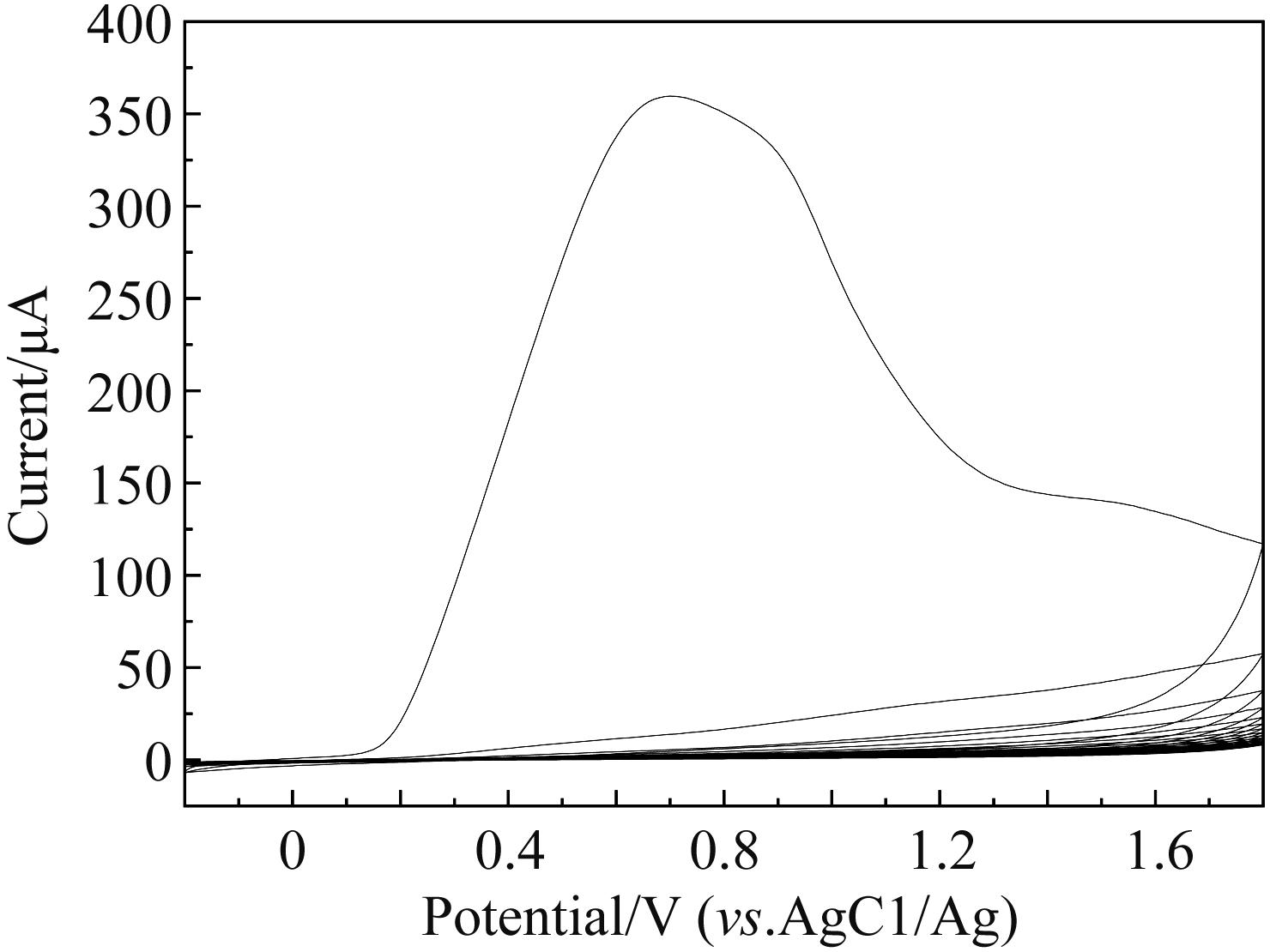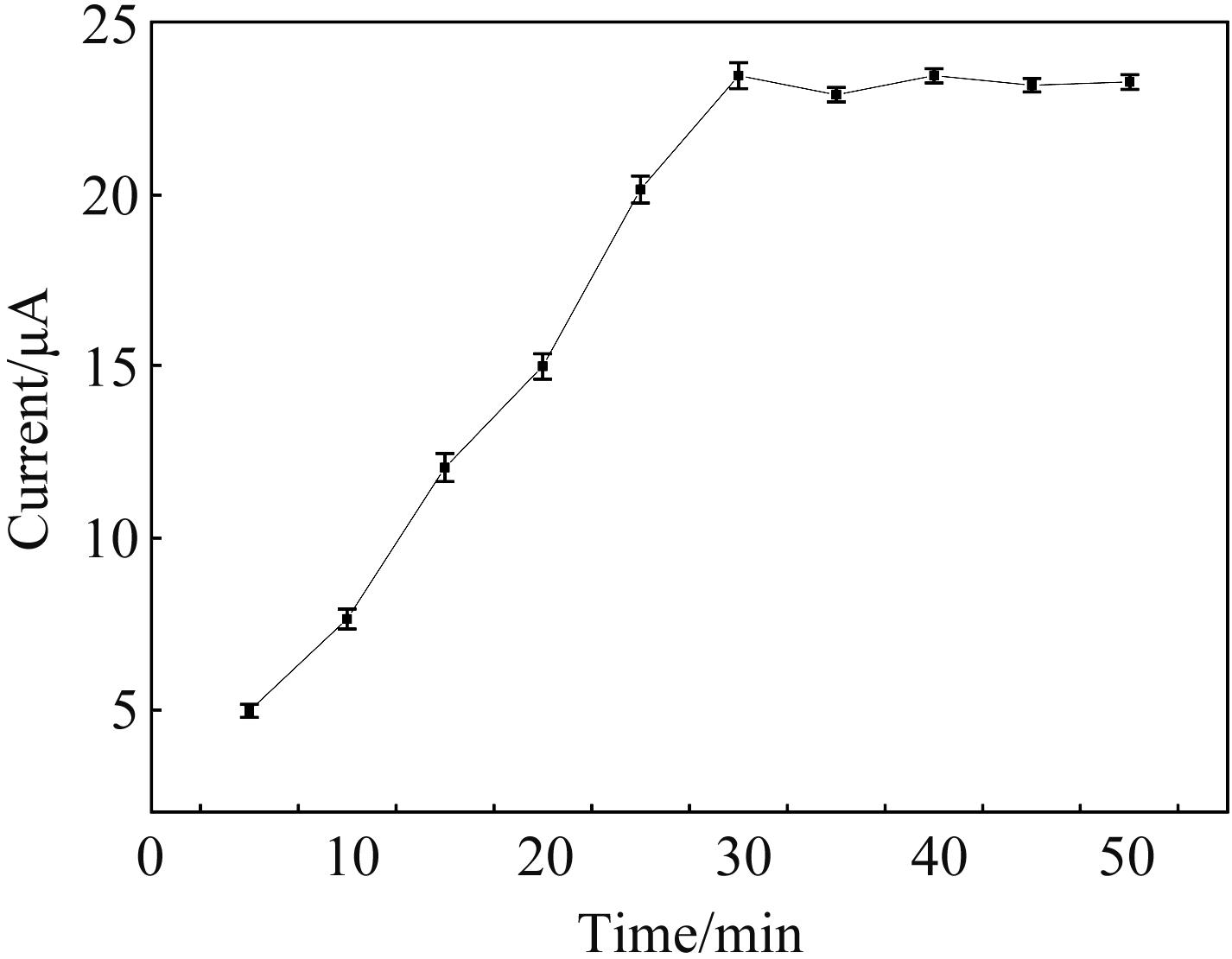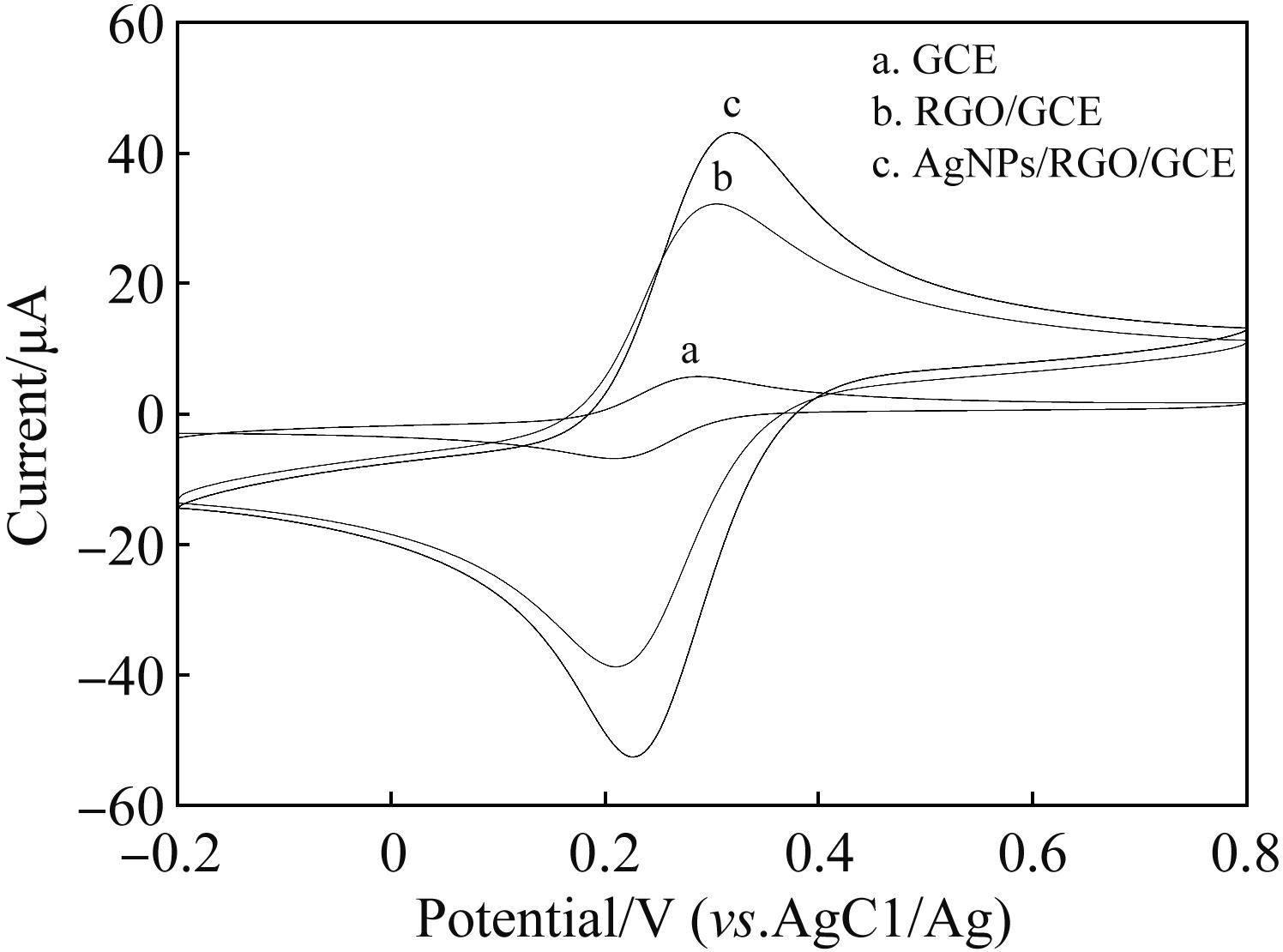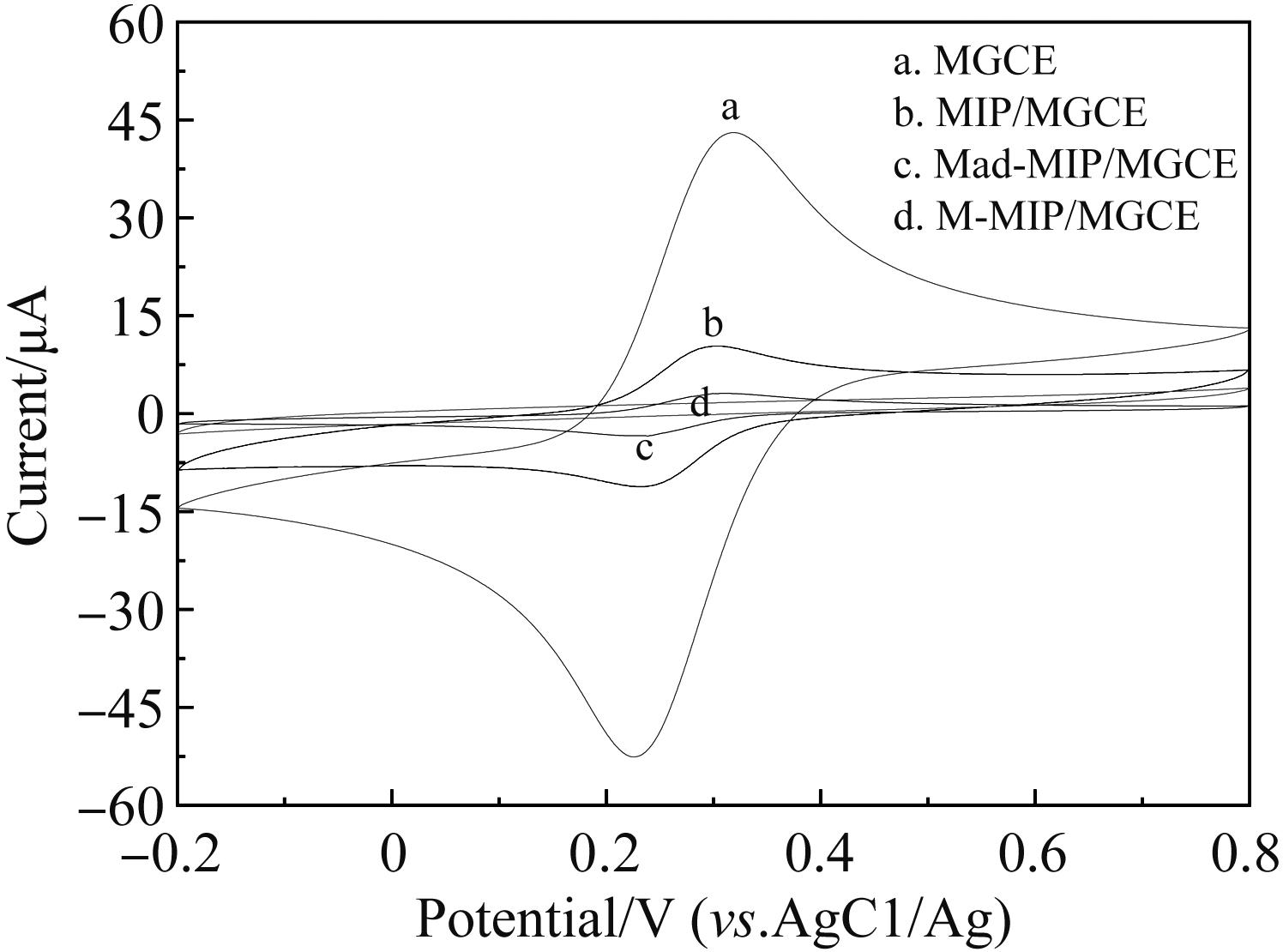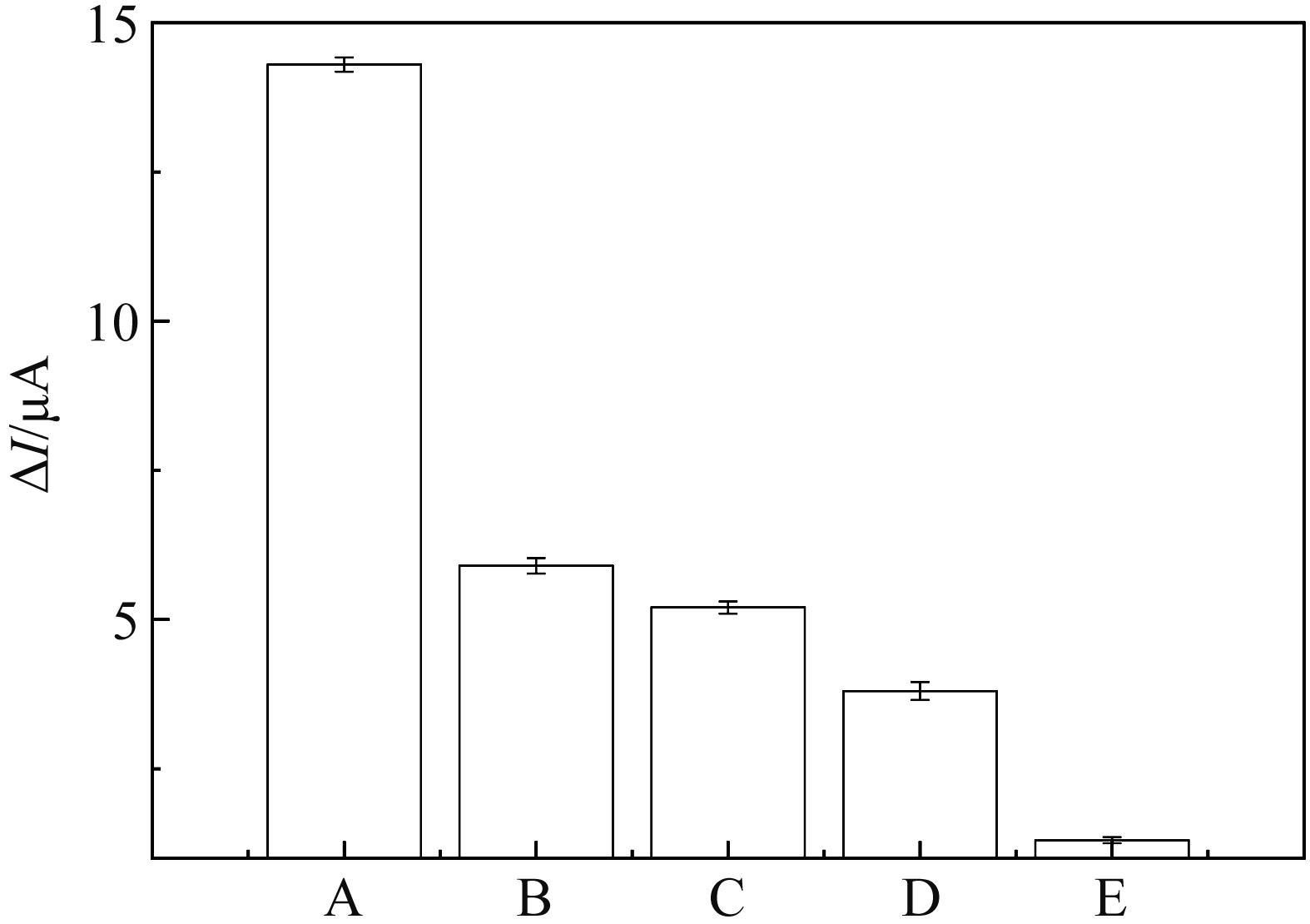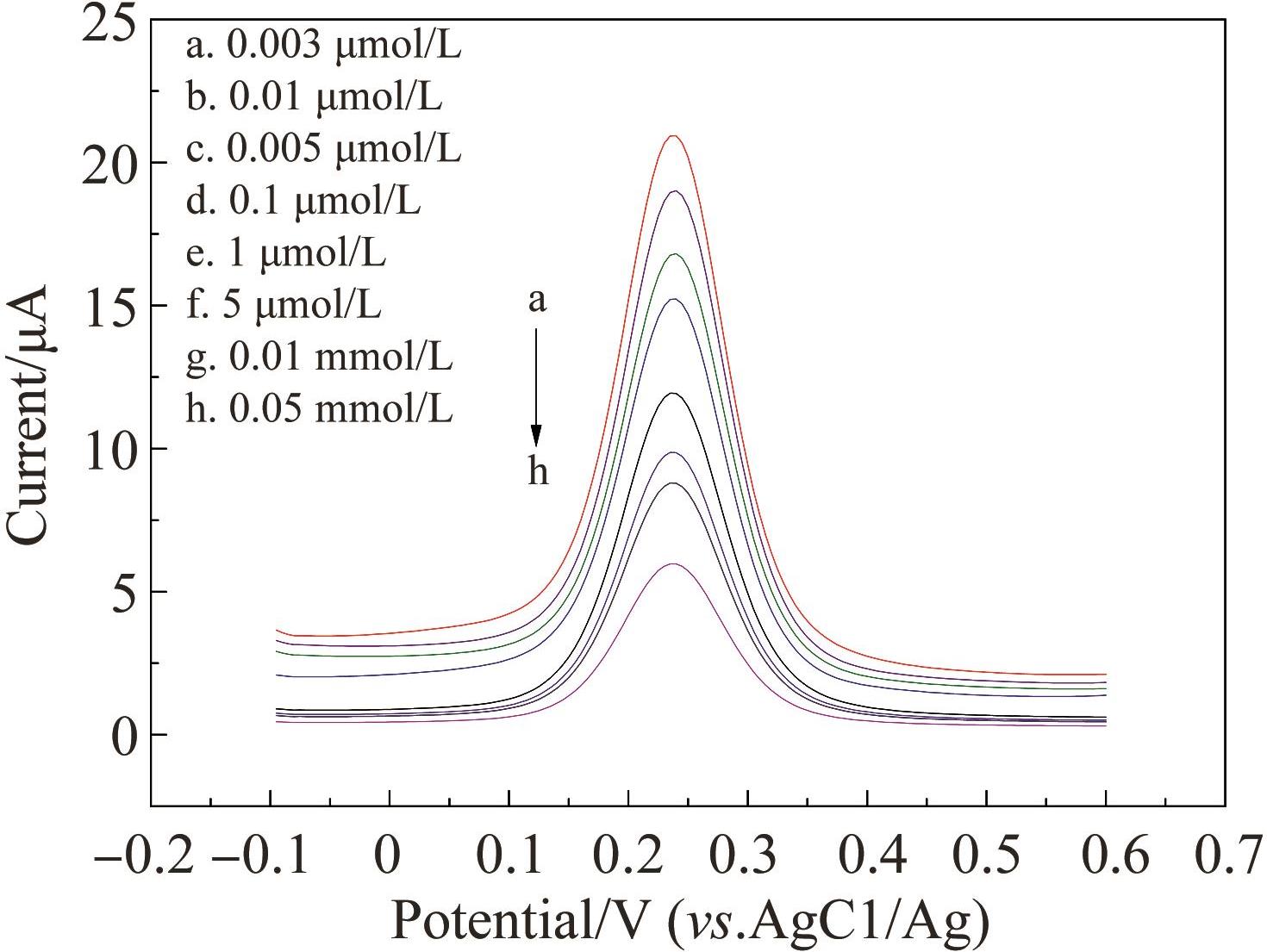
Chinese Journal of Applied Chemistry ›› 2022, Vol. 39 ›› Issue (7): 1052-1064.DOI: 10.19894/j.issn.1000-0518.210164
• Full Papers • Previous Articles Next Articles
Preparation and Application of Basic OrangeⅡImprinted Sensor
Dong-Dong LI, Li QIN, Lu-Hua TANG, Wen-Hui GAO( )
)
- College of Food and Biology,Hebei University of Science and Technology,Shijiazhuang 050000,China
-
Received:2021-04-06Accepted:2021-07-30Published:2022-07-01Online:2022-07-11 -
Contact:Wen-Hui GAO -
About author:wenhuigao@126.com
-
Supported by:the Postgraduate Innovation Funding Project of Hebei Province(CXZZSS2021101);the Key Research and Development Program Project of Hebei Province(19275505D);the Science and Technology Research and Development Plan Project of Shijiazhuang(211170183A)
CLC Number:
Cite this article
Dong-Dong LI, Li QIN, Lu-Hua TANG, Wen-Hui GAO. Preparation and Application of Basic OrangeⅡImprinted Sensor[J]. Chinese Journal of Applied Chemistry, 2022, 39(7): 1052-1064.
share this article
Add to citation manager EndNote|Ris|BibTeX
URL: http://yyhx.ciac.jl.cn/EN/10.19894/j.issn.1000-0518.210164
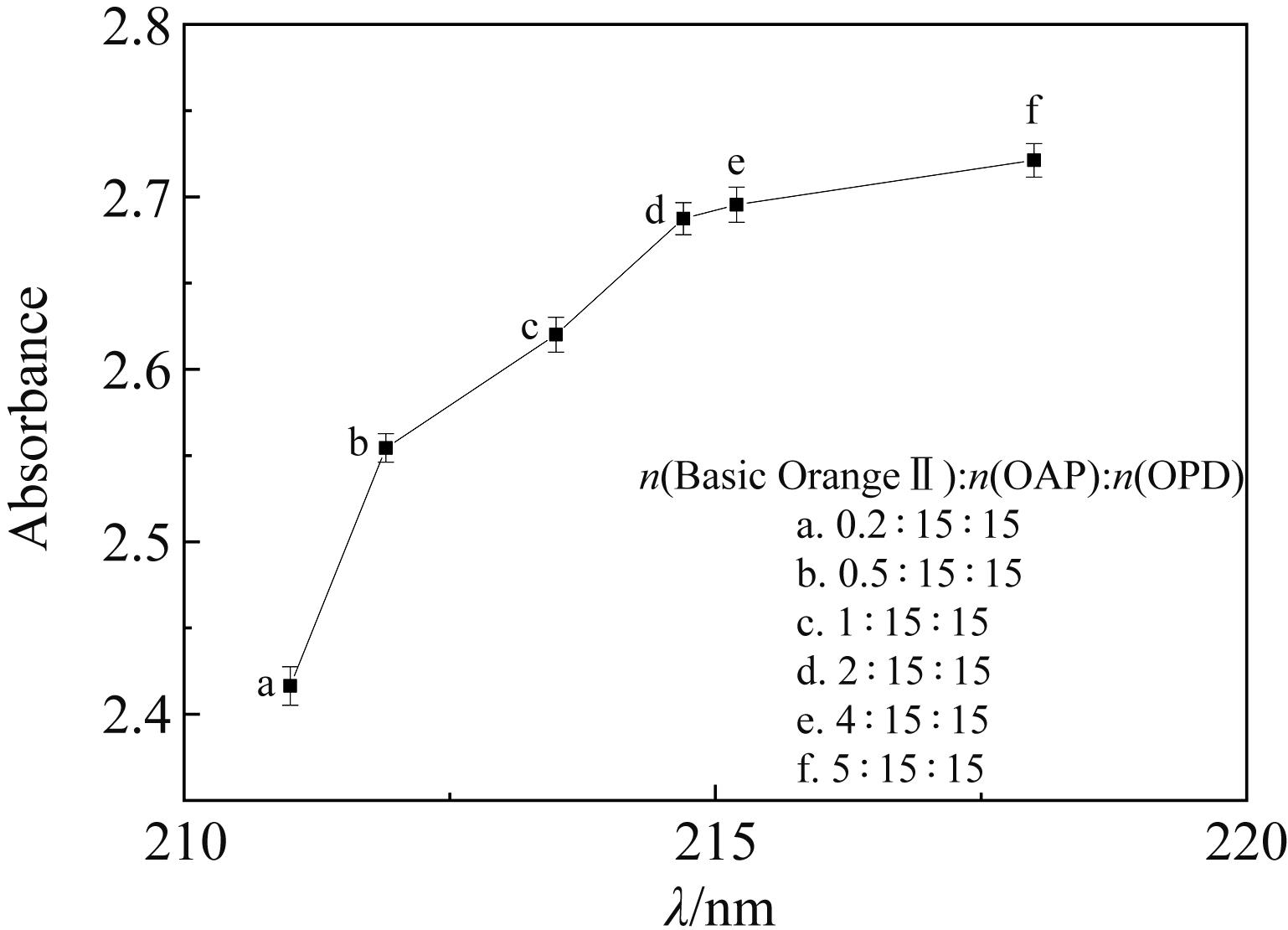
Fig.7 The variation trend of the maximum absorption wavelength and absorption value of template molecules and composite functional monomers with different concentrations
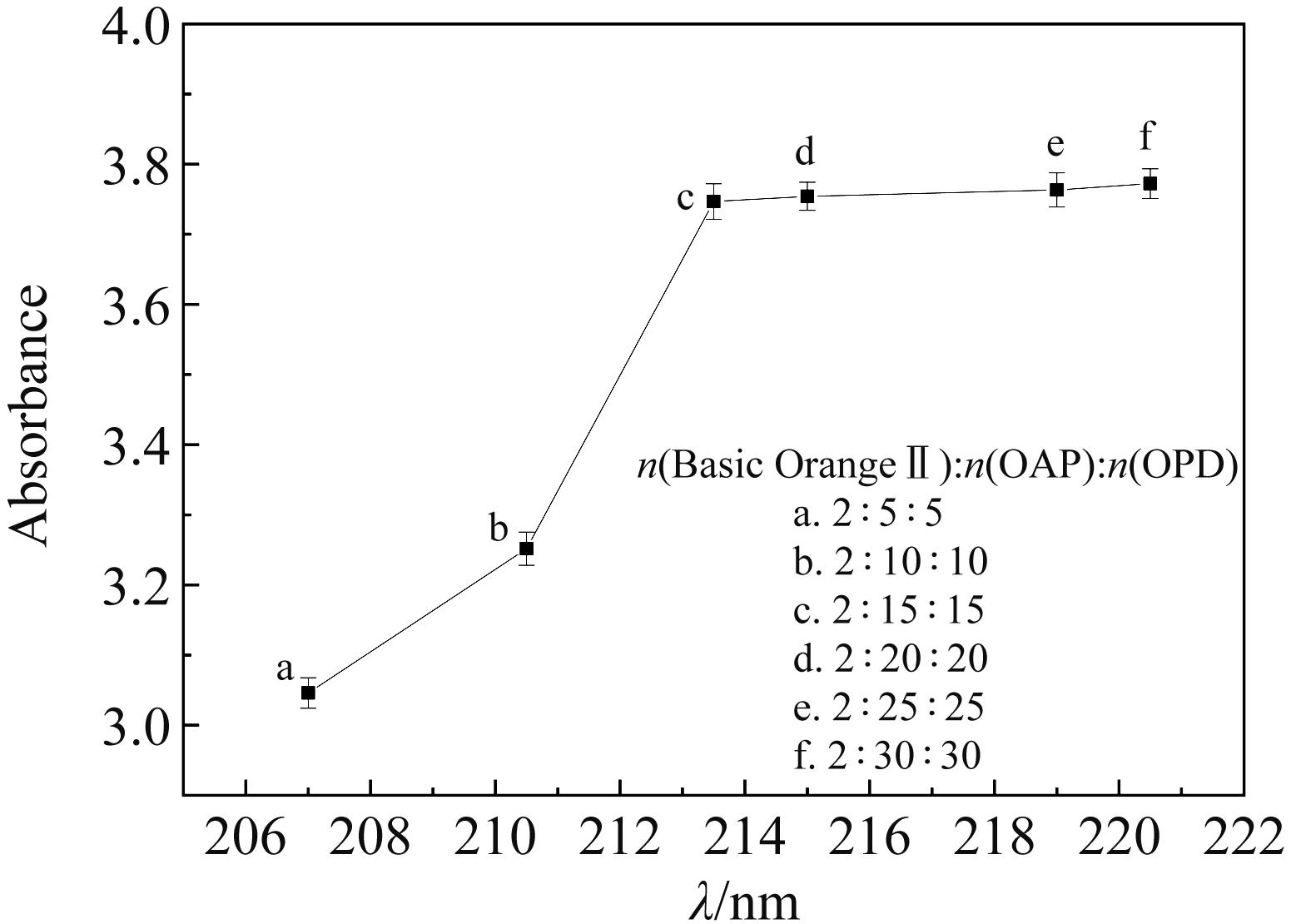
Fig.8 The relationship between the absorption value and the maximum absorption wavelength of template molecules and different proportion of functional monomers
样品 Sample | 辣椒面 Chili powder | 腐竹 Bean curd stick | 豆皮 Bean curd | ||||||
|---|---|---|---|---|---|---|---|---|---|
添加水平 Added levels/(mol·L-1) | 3.0×10-9 | 2.0×10-8 | 3×10-7 | 3.0×10-9 | 2.0×10-8 | 3×10-7 | 3.0×10-9 | 2.0×10-8 | 3×10-7 |
测定次数 Number of measurements | 回收率 Recovery/% | ||||||||
| 1 | 87.91 | 94.65 | 102.01 | 92.54 | 96.46 | 98.63 | 89.41 | 97.38 | 103.45 |
| 2 | 90.72 | 95.03 | 99.48 | 88.69 | 94.74 | 97.65 | 87.82 | 96.44 | 101.21 |
| 3 | 86.87 | 94.59 | 98.96 | 91.35 | 97.82 | 98.99 | 92.73 | 96.81 | 99.38 |
| 4 | 89.23 | 95.46 | 99.75 | 90.82 | 93.61 | 101.05 | 89.64 | 95.53 | 100.02 |
| 5 | 87.54 | 98.18 | 101.92 | 87.73 | 97.15 | 98.24 | 91.12 | 92.67 | 102.94 |
平均回收率 Average recovery/% | 88.45 | 95.58 | 100.42 | 90.23 | 95.96 | 98.91 | 90.14 | 95.77 | 101.40 |
相对标准偏差 RSD/% | 1.73 | 1.56 | 1.43 | 2.19 | 1.82 | 1.31 | 2.06 | 1.94 | 1.75 |
Table 1 Recovery and precision of capsicum powder and bean products(n=5)
样品 Sample | 辣椒面 Chili powder | 腐竹 Bean curd stick | 豆皮 Bean curd | ||||||
|---|---|---|---|---|---|---|---|---|---|
添加水平 Added levels/(mol·L-1) | 3.0×10-9 | 2.0×10-8 | 3×10-7 | 3.0×10-9 | 2.0×10-8 | 3×10-7 | 3.0×10-9 | 2.0×10-8 | 3×10-7 |
测定次数 Number of measurements | 回收率 Recovery/% | ||||||||
| 1 | 87.91 | 94.65 | 102.01 | 92.54 | 96.46 | 98.63 | 89.41 | 97.38 | 103.45 |
| 2 | 90.72 | 95.03 | 99.48 | 88.69 | 94.74 | 97.65 | 87.82 | 96.44 | 101.21 |
| 3 | 86.87 | 94.59 | 98.96 | 91.35 | 97.82 | 98.99 | 92.73 | 96.81 | 99.38 |
| 4 | 89.23 | 95.46 | 99.75 | 90.82 | 93.61 | 101.05 | 89.64 | 95.53 | 100.02 |
| 5 | 87.54 | 98.18 | 101.92 | 87.73 | 97.15 | 98.24 | 91.12 | 92.67 | 102.94 |
平均回收率 Average recovery/% | 88.45 | 95.58 | 100.42 | 90.23 | 95.96 | 98.91 | 90.14 | 95.77 | 101.40 |
相对标准偏差 RSD/% | 1.73 | 1.56 | 1.43 | 2.19 | 1.82 | 1.31 | 2.06 | 1.94 | 1.75 |
样品 Sample | 火腿肠 Ham sausage | 卤蛋 Marinated egg | ||||
|---|---|---|---|---|---|---|
添加水平 Added levels/(mol·L-1) | 3.0×10-9 | 2.0×10-8 | 3×10-7 | 3.0×10-9 | 2.0×10-8 | 3×10-7 |
测定次数 Number of measurements | 回收率 Recovery/% | |||||
| 1 | 93.27 | 96.43 | 98.58 | 88.34 | 95.08 | 102.35 |
| 2 | 87.01 | 95.82 | 102.77 | 92.72 | 95.72 | 100.73 |
| 3 | 92.64 | 93.29 | 102.81 | 90.56 | 94.23 | 99.52 |
| 4 | 89.53 | 95.17 | 101.23 | 89.91 | 92.16 | 98.47 |
| 5 | 91.75 | 93.08 | 99.46 | 86.83 | 94.67 | 98.90 |
平均回收率 Average recovery/% | 90.84 | 94.76 | 100.97 | 89.67 | 94.37 | 99.99 |
相对标准偏差 RSD/% | 2.83 | 1.59 | 1.90 | 2.49 | 1.43 | 1.57 |
Table 2 Recovery and precision of ham sausage and brine egg(n=5)
样品 Sample | 火腿肠 Ham sausage | 卤蛋 Marinated egg | ||||
|---|---|---|---|---|---|---|
添加水平 Added levels/(mol·L-1) | 3.0×10-9 | 2.0×10-8 | 3×10-7 | 3.0×10-9 | 2.0×10-8 | 3×10-7 |
测定次数 Number of measurements | 回收率 Recovery/% | |||||
| 1 | 93.27 | 96.43 | 98.58 | 88.34 | 95.08 | 102.35 |
| 2 | 87.01 | 95.82 | 102.77 | 92.72 | 95.72 | 100.73 |
| 3 | 92.64 | 93.29 | 102.81 | 90.56 | 94.23 | 99.52 |
| 4 | 89.53 | 95.17 | 101.23 | 89.91 | 92.16 | 98.47 |
| 5 | 91.75 | 93.08 | 99.46 | 86.83 | 94.67 | 98.90 |
平均回收率 Average recovery/% | 90.84 | 94.76 | 100.97 | 89.67 | 94.37 | 99.99 |
相对标准偏差 RSD/% | 2.83 | 1.59 | 1.90 | 2.49 | 1.43 | 1.57 |
方法 Methods | 线性关系 Linear range/(mol·L-1) | 检出限 Detection limit/(μg·L-1) | 文献 Ref. |
|---|---|---|---|
| MIP | 5.0×10-8~5.0×10-6 | 4.2 | [ |
| GB/T 23496?2009 | —— | 0.36 | |
| HPLC | 2.0×10-5~4.0×10-4 | 10.0 | [ |
| TLC?SERS | —— | 1.0×103 | [39] |
| DART?Q?Orbitrap MS | 4.0×10-6~8.0×10-5 | 2.0×102 | [ |
| MIP/MGCE | 3.0×10-9~5.0×10-5 | 0.25 | This work |
Table 3 Comparison with other methods for determination of alkaline orange Ⅱ
方法 Methods | 线性关系 Linear range/(mol·L-1) | 检出限 Detection limit/(μg·L-1) | 文献 Ref. |
|---|---|---|---|
| MIP | 5.0×10-8~5.0×10-6 | 4.2 | [ |
| GB/T 23496?2009 | —— | 0.36 | |
| HPLC | 2.0×10-5~4.0×10-4 | 10.0 | [ |
| TLC?SERS | —— | 1.0×103 | [39] |
| DART?Q?Orbitrap MS | 4.0×10-6~8.0×10-5 | 2.0×102 | [ |
| MIP/MGCE | 3.0×10-9~5.0×10-5 | 0.25 | This work |
| 1 | ZHENG L X, FENG J W, TIAN S M. Effects of basic orange II on proliferation and differentiation of limb bud cells in rat embryos[J]. J Hyg Res, 2015, 44(1): 15-17, 22. |
| 2 | 食品整治办[2008]3号文件.《食品中可能违法添加的非食用物质和易滥用的食品添加剂品种名单(第一批)》. |
| Food Regulation Office [2008] No. 3 document. List of non-edible substances possible illegal additives and food additives liable to abuse in food (Batch 1). | |
| 3 | WEISZ A, JAMES I C, TAE C J, et al. Determination of Sudan I and a newly synthesized Sudan III positional isomer in the color additive D&C Red No. 17 using high-performance liquid chromatography[J]. Food Add Contam Part A, 2017, 34(11): 1831-1841. |
| 4 | 杨园园, 许乾丽, 黎殊. HPLC法同时测定辣椒面中碱性橙2, 21, 22和酸性橙Ⅱ的含量[J]. 中国调味品, 2018, 43(6): 165-167. |
| YANG Y Y, XU Q L, LI S. HPLC method for simultaneous determination of soon, alkaline orange 2, 21, 22 and acid orange Ⅱ content[J]. China Condiment, 2018, 43(6): 165-167. | |
| 5 | NEBOT C, IGLESIAS A, BARREIRO R, et al. A simple and rapid method for the identification and quantification of malachite green and its metabolite in hake by HPLC-MS/MS[J]. Food Control, 2013, 31(1): 102-107. |
| 6 | 史新宇, 梅英杰, 黄锦燕, 等. 超高效液相色谱-串联质谱法同时检测火锅底料中罗丹明B、碱性橙2、酸性橙2和碱性嫩黄O[J]. 当代化工研究, 2020(14): 28-30. |
| SHI X Y, MEI Y J, HUANG J Y, et al. Simultaneous determination of rhodamine B, basic orange 2, acid orange 2 and basic light yellow O in hotpot base by UPLC-MS/MS[J]. Mod Chem Res, 2020(14): 28-30. | |
| 7 | YAN C L, ZHANG R X, CHEN Y J, et al. Electrochemical determination of enrofloxacin based on molecularly imprinted polymer via one-step electro-copolymerization of pyrrole and o-phenylenediamine[J]. J Electroanal Chem, 2017, 806(12): 130-135. |
| 8 | XU Z Y, JIANG X X, LIU S P, et al. Sensitive and selective molecularly imprinted electrochemical sensor based on multi-walled carbon nanotubes for doxycycline hyclate determination[J]. Chinese Chem Lett, 2020, 31(1): 185-188. |
| 9 | JALALVAND A R, ZANGENEH M M, JALILI F, et al. An elegant technology for ultrasensitive impedimetric and voltammetric determination of cholestanol based on a novel molecularly imprinted electrochemical sensor[J]. Chem Phys Lipids, 2020, 229: 104895. |
| 10 | TARCAN R, TODORBOE O, PETROVAI I, et al. Reduced graphene oxide today[J]. Mater Chem C, 2020, 8: 1198. |
| 11 | MA Y, HU Q, LIU C, et al. A nanospherical conjugated microporous polymer-graphene nanosheets modified molecularly imprinted electrochemical sensor for high sensitivity detection of α-Synuclein[J]. J Electroanal Chem, 2020, 862: 113994. |
| 12 | AZIZOLLAH N, AHMADI B G. Multivariate optimization of mebeverine analysis using molecularly imprinted polymer electrochemical sensor based on silver nanoparticles[J]. J Food Drug Anal, 2019, 27(1): 305-314. |
| 13 | ERADY V, MASCARENHAS R J, SATPTI A K, et al. Sensitive detection of ferulic acid using multi-walled carbon nanotube decorated with silver nano-particles modified carbon paste electrode[J]. J Electroanal Chem, 2017, 806(12): 22-31. |
| 14 | QI P P, WANG J, WANG Z W, et al. Construction of a probe-immobilized molecularly imprinted electrochemical sensor with dual signal amplification of thiol graphene and gold nanoparticles for selective detection of tebuconazole in vegetable and fruit samples[J]. Electrochim Acta, 2018, 274(6): 406-414. |
| 15 | MOTIA S, TUDOR I A, RIBEIRO P A, et al. Electrochemical sensor based on molecularly imprinted polymer for sensitive triclosan detection in wastewater and mineral water[J]. Sci Total Environ, 2019, 664: 647-658. |
| 16 | BAI H P, WANG C Q, CHEN J, et al. Graphene@AuNPs modified molecularly imprinted electrochemical sensor for the determination of colchicine in pharmaceuticals and serum[J]. J Electroanal Chem, 2018, 816: 7-13. |
| 17 | JIN H, GUO H J, GAO X H, et al. Selective and sensitive electrochemical sensing of gastrodin based on nickel foam modified with reduced graphene oxide/silver nanoparticles complex-encapsulated molecularly imprinted polymers[J]. Sens Actuators B: Chem,2018, 277: 14-21. |
| 18 | 田景升, 李东东, 赵玲钰, 等. 喹乙醇印迹传感器的制备及其在喹噁啉类药物残留快检中的应用[J]. 食品科学, 2021, 42(6): 316-324. |
| TIAN J S, LI D D, ZHAO L Y, et al. Preparation and application of molecularly imprinted electrochemical sensor for rapid detection of quinoxaline drug residues[J]. Food Sci, 2021, 42(6): 316-324. | |
| 19 | 智康康, 董爱军, 杨鑫, 等. 双功能单体法制备磁性葡萄糖分子印迹聚合物及其吸附性能研究[J]. 化学学报, 2016, 74(2): 199-207. |
| ZHI K K, DONG A J, YANG X, et al. Preparation of magnetic glucose molecularly imprinted polymers by bifunctional monomer method and its adsorption properties[J]. Acta Chim Sin, 2016, 74(2): 199-207. | |
| 20 | ZHAO W R, KANG T F, LU L P, et al. A novel electrochemical sensor based on gold nanoparticles and molecularly imprinted polymer with binary functional monomers for sensitive detection of bisphenol A[J]. J Electroanal Chem, 2017, 786: 102-111. |
| 21 | 秦思楠, 唐录华, 高文惠. 三氟氯氰菊酯分子印迹电化学传感器的制备及性能研究与应用[J]. 应用化学, 2019, 36(8): 958-967. |
| QIN S N, TANG L H, GAO W H. Cyhalothrin molecularly imprinted electrochemical sensor:preparation, performance and application[J]. Chinese J Appl Chem, 2019, 36(8): 958-967. | |
| 22 | 赵玲钰, 高林, 庞军, 等. 胺菊酯分子印迹电化学传感器的制备及性能[J]. 食品科学, 2017, 38(8): 283-289. |
| ZHAO L Y, GAO L, PANG J, et al. Preparation and performance of a molecularly imprinted electrochemical sensor based on methrin[J]. Food Sci, 2017, 38(8): 283-289. | |
| 23 | GEORGITSOPOULOU S, PETRAI O, GEORGAKILAS V. Highly conductive functionalized reduced graphene oxide[J]. Surf Interface, 2019, 16: 152-156. |
| 24 | 尤文钰, 杨铁金. 纳米银/石墨烯修饰电极测定青蒿素[J]. 化学通报, 2016, 79(11): 1035-1040. |
| YOU W Y, YANG T J. A glassy carbon electrode modified with graphene and silver nanoparticles for determination of artemisinin[J]. Chemistry, 2016, 79(11): 1035-1040. | |
| 25 | 金葆康, 王世君, 张自品. 纳米银修饰电极的制备及表征[J]. 安徽大学学报(自然科学版), 2005, 29(5): 74-77. |
| JIN B K, WANG S J, ZHANG Z P. Fabrication and characterization of Ag nanoparticles modified electrode[J]. J Anhui Univ (Nat Sci Ed), 2005, 29(5): 74-77. | |
| 26 | 高文惠, 刘博, 李兴峰, 等. 制备腈菌唑分子印迹聚合物前功能单体选择研究[J]. 光谱学与光谱分析, 2014, 34(3): 791-794. |
| GAO W H, LIU B, LI X F, et al. Selection of functional monomers before preparation of nitrilomycinazole molecularly imprinted polymer[J]. Spectrosc Spectr Anal, 2014, 34(3): 791-794. | |
| 27 | 王晓娇. 石墨烯复合材料修饰电极对食品添加剂的测定研究[D]. 济南: 济南大学, 2016. |
| WANG X J. Study on determination of food additives by graphene composite modified electrode[D]. Jinan: Jinan University, 2016. | |
| 28 | 刘拥亮, 李红梅. 高效液相色谱-紫外检测豆制品中碱性橙Ⅱ的含量[J]. 绿色科技, 2019, (10): 278-279, 292. |
| LIU Y L, LI H M. High performance liquid chromatography with ultraviolet detection of alkaline orange Ⅱ content in soy products[J]. J Green Sci Technol, 2019, (10): 278-279, 292. | |
| 29 | 符云鹏, 齐颖, 扈晓鹏, 等. TLC-SERS联用快速同时检测食品中非法添加的碱性橙Ⅱ和酸性橙Ⅱ的研究[J]. 光谱学与光谱分析, 2018, 38(8): 2419-2424. |
| FU Y P, QI Y, HU X P, et al. Used TLC-SERS combination added illegally in the rapid detection of food at the same time, alkaline acid orange orange Ⅱ and Ⅱ research[J]. Spectrosc Spectr Anal, 2018, 38(8): 2419-2424. | |
| 30 | 刘喆, 迟鸿悦, 赵彩秀, 等. DART-Q-Orbitrap MS法快速检测豆制品中碱性橙Ⅱ和金胺O[J]. 质谱学报, 2019, 40(1): 42-49. |
| LIU Z, CHI H Y, ZHAO C X, et al. DART-Q-Orbitrap MS method for rapid detection of soy products in alkaline orange Ⅱ and auramine O[J]. J Chinese Mass Spectrom Soc, 2019, 40(1): 42-49. |
| [1] | Shan SHAO, Jian ZHANG, Kai-Qiang DENG, Jie YANG, Shao-Ming YANG. Detection of Dopamine by Enzyme‑Free Sensor Constructed by Nickel‑Cobalt Bimetallic‑porphyrin Organic Framework Composites [J]. Chinese Journal of Applied Chemistry, 2022, 39(7): 1098-1107. |
| [2] | Zhen-Hua LI, Ying ZHU, Jing CHEN, Shi-Ping SONG. Advances in Construction and Electrochemical Biosensing of Antifouling Interfaces [J]. Chinese Journal of Applied Chemistry, 2022, 39(5): 736-748. |
| [3] | Li QIN, Xiao-Ting YOU, Lu-Hua TANG, Jian-Wen LI, Yin ZHANG, Wen-Hui GAO, Jun-Hua HAN. Preparation and Application of Auramine O Imprinted Sensor Based on Nanomaterials Modification [J]. Chinese Journal of Applied Chemistry, 2022, 39(12): 1880-1890. |
| [4] | LI Zi-Yue, YANG Tong-Ren, YANG Ge, HUANG Yuan-Yu. Research Progresses of Nucleic Acid Based Detection of Pathogenic Microorganisms [J]. Chinese Journal of Applied Chemistry, 2021, 38(5): 592-604. |
| [5] | ZHANG Miao, ZHENG Lei, DING Liang. Rapid Detection System Based on the Weighing Titration Method in Drinking Water [J]. Chinese Journal of Applied Chemistry, 2021, 38(4): 457-464. |
| [6] | QIN Sinan, TANG Luhua, GAO Wenhui. Cyhalothrin Molecularly Imprinted Electrochemical Sensor:Preparation, Performance and Application [J]. Chinese Journal of Applied Chemistry, 2019, 36(8): 958-967. |
| [7] | XING Chenli, WANG Jing, ZHANG Zhaohui, XIE Dandan, LÜ Piaopiao. Multiple Metal Ion Imprinted Electrochemical Sensor with Enhanced Sensitivity by Graphene Oxide-C60 Composite [J]. Chinese Journal of Applied Chemistry, 2019, 36(3): 341-348. |
| [8] | DING Hao, YAN Fei, ZHENG Wenjing, GUO Weiliang, SU Bin. Electrochemical Detection of Antioxidants in Cosmetic Samples Using Mesoporous Silica Film and Confined Micelles [J]. Chinese Journal of Applied Chemistry, 2017, 34(11): 1307-1313. |
| [9] | DING Hao, YAN Fei, ZHENG Wenjing, GUO Weiliang, SU Bin. Electrochemical Detection of Antioxidants in Cosmetic Samples Using Mesoporous Silica Film and Confined Micelles [J]. Chinese Journal of Applied Chemistry, 2017, 34(11): 0-0. |
| [10] | LIU Rong, ZHONG Tongsheng*, LONG Liping, YIN Zhifang, CAO Wei. Fabrication and Application of Chlorpromazine Molecular Imprinting Film Sensor [J]. Chinese Journal of Applied Chemistry, 2013, 30(11): 1361-1365. |
| [11] | KULISONG Hayierbiek, ZENG Han*. Direct Electrochemical Behavior and Sensing Performance of Nitrogen-Doped Meso-Porous Carbon and Chitosan Composite Immobilized with Laccase Modified Electrode [J]. Chinese Journal of Applied Chemistry, 2013, 30(10): 1194-1201. |
| [12] | LUO Qimei, LI Zhen, WANG Huixian, LIU Dengyou* . A Methyl Parathion Electrochemical Sensor Based on Poly(glutamic acid) Modified Glass Carbon Electrodes [J]. Chinese Journal of Applied Chemistry, 2013, 30(09): 1082-1088. |
| [13] | HUANG Lu1, YANG Yao1, PAN Daodong1,2*. Electrocatalytic Oxidation of Ammonia with Ir Catalysts Supported on TiO2 [J]. Chinese Journal of Applied Chemistry, 2013, 30(05): 584-589. |
| [14] | YU Mingzhu1, LI linru1, LU Tianhong1, CHEN Zhaoyang2, MA Chunan2, DU Jiangyan1*. Electrocatalytic Performanace of Ir Catalyst Supported on Mixture of WC and Vulcan XC-72 Carbon for Ammonia Oxidation [J]. Chinese Journal of Applied Chemistry, 2013, 30(04): 448-452. |
| [15] | LI Linru1, CHEN Chong1, XU Bin2, CAO Gaoping2, YANG Yusheng2, LU Tianhong1,3*. Electrocatalytic Performance of Ir Catalyst Supported on Macropore Carbon for Ammonia Oxidation [J]. Chinese Journal of Applied Chemistry, 2012, 29(01): 95-99. |
| Viewed | ||||||
|
Full text |
|
|||||
|
Abstract |
|
|||||

